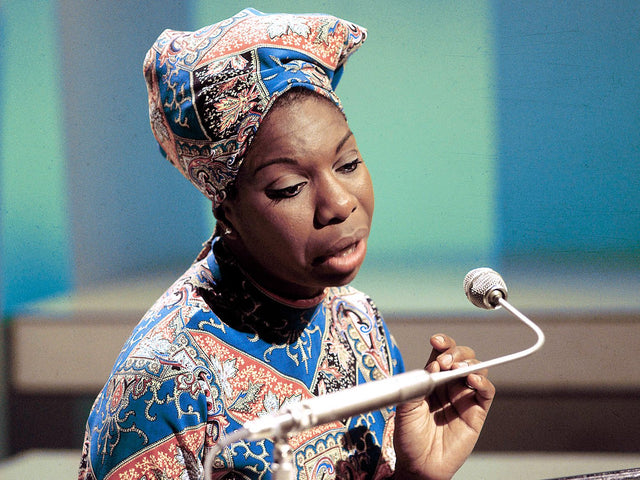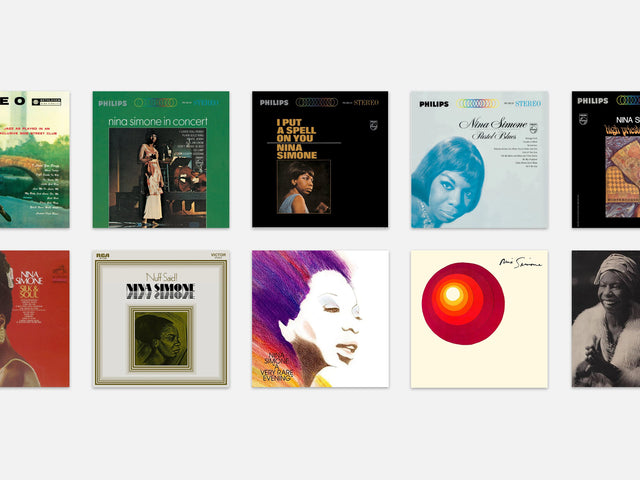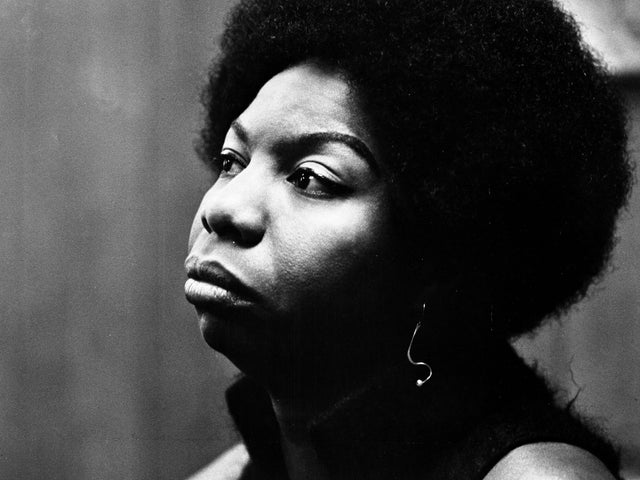The Artist Who Created The Nina Simone Print On What Inspires Her
We sat down to talk with Melana Bass, the UW-Madison First Wave scholar and artist who created the unique art print included in our Nina Simone Sings the Blues packages. Here she talks about her art, Nina Simone’s beauty and music and the inspiration she drew from it, and the process of making this month’s print.
Vinyl Me, Please: Where do you get inspiration for you pieces?
Melana Bass: I draw a lot of my inspiration from being a black woman from the south side of Chicago. A lot of times my surroundings would drive me to continue to express myself. Art is one of those things that I always wanted to do, continuously do. So I’d say that being from that neighborhood, Englewood in Chicago, helped me with a lot of inspiration.
Also, just being a black woman, period. Just talking about black women all the time in my artwork, talking about black men, hip hop, history—a lot of my work is centered around black culture and really celebrating the image of black people. Because before, a lot of my work was like harsh images, and they would be about social justice, but it would be more of a negative image. But now, I focus more so on showing the joy and pride behind black women; that’s why a lot of them look serene, they have their eyes closed, there are these wildly bright colors.
How does your identity and experiences as a black woman influence your work?
I think about what black women would wanna be told. I think about how they would wanna be portrayed. I think about the type of things we say, as black women, the way that we encourage each other. All of these thing that I think about as a black woman, and the things that I think about when I hear a black woman speak on their experiences, it kind of drives me in a creative manner to create these pieces.
I’m thinking about these ideas right now, even, of black women kind of like mean mugging. Because, you know, people are always talking about the angry black woman and how black women have attitude problems and stuff like that. And, in a way, I wanna put that still on these bright color backgrounds. So it’ll be like, you wanna be happy when you see these bright colors, but you see these black women frowning or mean mugging. Things like that are what drives me. And that’s directly from the experiences, my experiences, as a black women, being told all the time personally that I always look like I’m frowning about something.
Or just, even where I’m from, just all the things that black women say like “sugar honey iced tea,” or just all the little stuff that we like to pick up and say around each other, all the little slangs—“girl, you slay,” “you on fleek,” “your edges is laid,” stuff like that. I think about ways to articulate that visually, and then I put it into a painting, essentially.
Can you describe your process when making a piece?
Usually it takes about four coats [of paint] before the colors are as bright as i want them to be. After that, I start to lightly sketch each figure onto the canvas. From there I work with Prismacolor pastels—the dry pastels, not the oil kind. And I just start to fill in and smear with my finger and shade, and just really follow the portrait and really follow the reference pictures. And it ends up becoming this beautiful portrait that develops on top of this already bright background. And so, from there, I usually clip from like magazines, I have a lot of decorative paper that i buy, metallic paper, sometimes even materials like fabric and stuff.
And I’ve been experimenting with this style for a while, it’s only been a few months that I’ve been collaging, but I really like it. I’ve just fell into this process, and it’s so dope. It’s a lot of cutting; that’s the only difference in my process now that has changed over the years.





What was your process like for the Nina Simone portrait?
Man, this project was super exciting, because this isn’t the first time I’ve done a project based on Nina Simone. I did a portrait of her before, and that was my first time ever really hearing about her music—this was probably about 2013, maybe. And so I was excited to do it this time around because, of course, I’ve gotten so much better as an artist since I last did a portrait of her. I did a portrait of her around the time I was first starting pastels. I just started out by Googling a bunch a pictures of her which, of course, made it even harder because she’s absolutely beautiful, so of course there was a lot to choose from.
After that, I just thought about Sings the Blues; even though it’s a blues album, I did wanna bring my style and still have those really bright colors, but I still stuck to the idea of the blues, and stuff like that. So I laid that down in the background and sketched it out, did the whole thing.
One of the things that stuck out the most about the process of this is that I was a little bit torn on what to do with the hair. Because, as I said before, my process is to have this wildly colored hair that’s made from all these different things. But for this, particularly, I didn’t know if I wanted to do that with Nina, and I didn’t know if I wanted to go that wild with this one. Because I wanted to bring myself, but I wanted to bring Nina at the same time. So, ultimately, I thought of this idea of the night sky, and the idea of depression, and the idea of being down at night but hoping that joy comes in the morning, and hoping that you find that light. I thought of that idea of darkness, so that’s why I chose to do like a little galaxy type of look in the hair, instead of collaging like I normally do. Which, you know, I’m very excited about that decision; I think the portrait turned out great. It definitely was an exciting project, overall.
 The art print Melana created for our Nina Simone package.
The art print Melana created for our Nina Simone package.
How did you draw from the album Nina Simone Sings the Blues to inspire your portrait?
I listened to it a lot while I was painting, which was interesting because it was very relaxing. And it was crazy how I was able to get such a high energy from such a relaxing album. And it’s just crazy because this is my second time actually listening to her for a project, in general. Her voice is just so unique, and it influenced me even more to come with heat, come with the best project I possibly can. Because I’m very inspired by Nina’s work. And the fact that, even little clips that I would watch on YouTube a while ago, she would be talking about how black is beautiful and stuff like that. And just to hear her saying that in these clips that were from years ago. You know this was before people were saying “My black is beautiful, this is a beautiful thing,” she was saying that a long time ago. So I just really respect Nina Simone, and I love the album in general; it’s amazing.
Do you have a favorite song off Nina Sings the Blues?
I don’t. I cannot decide at all. I refuse—I knew you guys were gonna ask me that (laughs).
Nina’s work played a huge role in the political climate and the ’60s Civil Rights movement; how does the current political climate impact your work and role as an artist?
I think about the political climate a lot in my work. Actually, I had my first solo show Black Girl Everything back in April, and that was my last set of really political work. None of my recent work has been really politically centered, but in that, I still took that joy idea, that idea of black girl magic, and I made these myths, these little mythical stories, and the portraits told that story of injustice through the back woman’s eyes.
Is there an overall message your hope your work leaves the viewer with?
Just having joy, just overall, even during the bad times. Because that’s kind of what I went for, being able to depict joy and bright colors, but still having the blues type of feeling to it. So I guess, being grateful, happy.
Where should people go if they want to check out more of your work?
Amileah Sutliff is a New York-based writer, editor and creative producer and an editor of the book The Best Record Stores in the United States.
Join the Club!
Join Now, Starting at $44Exclusive 15% Off for Teachers, Students, Military members, Healthcare professionals & First Responders - Get Verified!







